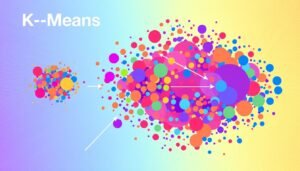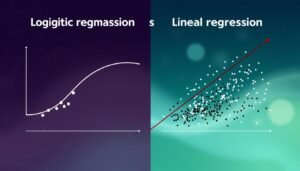Starting with machine learning can seem hard, but decision trees are easy to understand and very useful. They are a key part of supervised learning that makes data analysis simpler. They help us find patterns in data, which leads to better predictions in many areas like finance and healthcare.
Decision trees are great at both sorting data into groups and predicting values. They start with a main node and then split based on the best feature to reduce uncertainty. This makes them a must-know for anyone wanting to use predictive analytics in different fields.
To get good at using decision trees with Scikit-Learn, you need to understand their basics, common mistakes, and advanced methods. The process from getting the data ready to checking how well the model works is detailed. You need to know both the theory and how to apply it in practice.
Key Takeaways:
- Decision trees are a cornerstone of machine learning and predictive modeling.
- They are applicable in both classification and regression tasks in data analysis.
- Effective data splitting is key, using criteria like Information Gain and Gini Impurity.
- Scikit-Learn is a popular library for implementing and visualizing decision trees.
- Understanding decision trees involves knowing their structure, variants, and evaluation methods.
- Preventing overfitting and properly tuning decision trees are essential for reliable predictions.
- Additional resources and practice are invaluable for mastering decision trees in machine learning.
Demystifying Decision Trees in Machine Learning:
The decision tree algorithm makes complex decisions easier by showing choices and outcomes visually. It breaks down data into smaller parts, making analysis simpler. This helps in making informed decisions in fields like healthcare, finance, and marketing.
Each node in a decision tree is a decision point, and branches show possible paths. This structure helps consider all outcomes, making it great for predictions and classification.
| Industry | Applications | Key Benefits |
|---|---|---|
| Healthcare | Disease diagnosis, treatment customization | Accurate predictions tailored to individual patients leading to better outcomes |
| Finance | Credit scoring, fraud detection | Reduces financial risks by identifying probable defaulters and fraudulent activities |
| Marketing | Customer segmentation, churn prediction | Enhances targeting strategies, improving customer retention rates |
Decision trees can face issues like overfitting, where they learn too much from the data. To fix this, pruning and setting tree growth limits are key.
Machine learning decision trees don’t make assumptions about the data. This makes them flexible for handling different types of data. They’re also a base for more advanced models like Random Forests and Gradient Boosting, which improve predictions.
Here’s an example in Python using the sklearn library. It shows how to train and visualize a decision tree:
from sklearn import tree
X = [[0, 0], [1, 1]] # training data
Y = [0, 1] # class labels
clf = tree.DecisionTreeClassifier()
clf = clf.fit(X, Y)
tree.plot_tree(clf)

Decision trees are powerful for making decisions in many areas. But, it’s important to understand their structure and limitations. This knowledge helps use them to their fullest extent.
The Foundation of Decision Trees:
Decision trees are key machine learning algorithms used for data mining and classification trees. They make complex decisions simple by breaking them down into binary choices. This makes decision-making easier to understand.

Learning about decision tree classifiers starts with understanding how they work. They are used in many industries for different tasks.
Concept and Application of Decision Tree Algorithms:
Algorithms like ID3, C4.5, and CART are the heart of machine learning. They split data into smaller parts based on important attributes. This helps build accurate models and gives useful insights.
For example, ID3 uses entropy to find the best attribute to split the data. C4.5 improves this by using gain ratios. CART uses Gini impurity for both classification and regression tasks.
Understanding the Anatomy of a Decision Tree:
A decision tree has a simple structure. It starts with a root node and branches out. Each branch asks another question until it reaches a leaf node.
This structure helps the tree get clearer about the data at each step. It keeps dividing until it’s as clear as possible. This makes complex data easier to understand and predict.
Decision trees are used in many areas like healthcare, finance, and retail. They help find patterns in data. This leads to better, data-driven decisions.
How Decision Trees Pave the Way for Data Analysis
Decision trees are key in machine learning for simple and complex data analysis. They break down datasets and make complex decisions easy to understand. This helps find patterns and insights, making them essential in finance, healthcare, and retail.
Decision trees are great at handling complex data and are easy to understand. This makes them very useful in machine learning. They help businesses deal with the challenges of today’s data world. Plus, they make it easier to pick the most important data points.
The history of decision trees goes back to the 1960s with Edward Hunt and Philip Marin. Later, Ross Quinlan made big improvements in the 1980s and 1990s. His work, like ID3 and C4.5, made decision trees better at making decisions and improving predictive modeling.
| Algorithm | Attribute Selection Method | Typical Use |
|---|---|---|
| ID3 | Information Gain | Classification |
| C4.5 | Gain Ratio | Classification |
| CART | Gini Impurity/MSE | Both Classification & Regression |
Decision trees are clear and fast, but they have some problems. They can overfit and struggle with big data. But, by using the right algorithms and adjusting settings, these issues can be fixed.
Decision trees are used in many areas, like medicine and finance. They show how machine learning is changing. They give clear insights from complex data, helping make better decisions.
Classification vs Regression Trees: Knowing the Difference:
It’s important to know the difference between classification and regression trees in machine learning. These trees are used for different tasks. They help predict either categories or continuous values.
Defining Classification Trees in Real-World Scenarios:
Classification trees are used when the target variable is categorical. They are great at sorting and categorizing data. For example, in schools, they can use GRE scores and GPA to decide if a student gets in.
These trees can be very accurate. A model scored 92.5% in predicting student success. They help make decisions by sorting data into categories. This is useful in diagnosing diseases or spotting spam emails.
Regression Trees: Predicting Numerical Values:
Regression trees are for predicting continuous values. They are key in fields that need precise predictions. For example, they can estimate property values based on size and location.
A regression tree might predict a student’s admission chances based on GPA and research experience. It uses Mean Squared Error (MSE) to improve its accuracy. This shows how regression trees are great for predicting values.
Choosing between a decision tree classifier and a regression tree depends on the task. Classification trees are for predicting categories, while regression trees predict values. Both are powerful tools in machine learning, but they serve different needs. Understanding their roles helps in using them effectively in various fields.
Efficient Data Splitting with Decision Trees:
Learning to split data well in decision trees is key for better supervised learning. It’s not just about using the right algorithm. It’s also about making smart choices based on Information Gain and the Gini Index. These tools help find the best features and thresholds for splitting, aiming to reduce errors in predictions.
Criteria for Optimal Data Partitioning:
Choosing the right split point in decision trees is all about making the data more uniform. This helps in reducing mistakes in predictions. For numeric predictors, finding the right split can be tricky. That’s why tools like Information Gain are important to guide these decisions.
Impurity Measures: Gini Index and Information Gain:
Impurity measures are vital for improving a decision tree’s accuracy. The Gini Impurity aims to lower the chance of wrong predictions by making nodes pure. On the other hand, Information Gain looks at how much entropy is reduced after a split. These measures help make data-driven decisions in complex machine learning tasks.
Understanding how different methods impact data splitting is important. For example, supervised learning often uses Gini Impurity for categorical outcomes. This method calculates a weighted sum of the Gini impurities of child nodes, showing how effective a split is.
| Splitting Method | Used For | Description |
|---|---|---|
| Gini Impurity | Categorical Targets | Focuses on minimizing the probability of misclassification by maximizing node purity. |
| Information Gain | Categorical Targets | Assesses the reduction in entropy, aiding in selecting the most informative features for splitting. |
| Reduction in Variance | Continuous Targets | Used mainly in regression problems to minimize variance in node outcomes. |
| Chi-square | Categorical Targets | Statistical significance testing to find the best split points in classification scenarios. |
To learn more about how decision trees use Information Gain and the Gini Index, check out a guide on Data Science vs. Machine Learning. It explores how these tools help create more accurate models in these fields.
Decision Trees Algorithm Variants and Their Uses:
Decision trees are key in many fields like healthcare, finance, and retail. ID3, created in 1983, uses entropy to find the best splits. This helps with categorical data.
C4.5 improved upon ID3 by handling continuous data better. CART uses the Gini index for both classification and regression tasks. This makes it versatile for different data types.
CHAID focuses on categorical data with chi-square tests. MARS creates flexible regression models for non-linear data. This shows decision trees can handle more than just traditional classifications.
Using ensemble methods like Random Forests and Boosted Decision Trees improves accuracy. These methods combine multiple trees to avoid overfitting. This is important in studies where models fit too well to the training data.
Each decision tree has its own strengths. Terms like parent and child nodes, branches, and pruning are key. Pruning refines the model by removing less important nodes.
| Algorithm | Focus Area | Common Uses |
|---|---|---|
| ID3 | Entropy in Categorical Data | Basic classifications |
| C4.5 | Gain Ratio in Mixed Data | Advanced classifications with Continuous and Categorical Data |
| CART | Gini Index for Binary Splits | Classification and Regression Tasks |
| CHAID | Chi-square Test for Categorical Data | Data Segmentation and Prediction in Marketing |
| MARS | Flexible Regression Models | Complex non-linear relationships in large datasets |
Knowing the strengths and uses of these machine learning algorithms helps choose the right one. This makes analysis more effective. It uses decision trees to find important insights and guide decisions.
Building Predictive Models with Decision Trees:
Decision trees are a key part of machine learning. They are known for their simple yet effective approach to predicting outcomes. The decision tree classifier is a standout because of its ease of use and versatility.
Cleaning and Preparing Your Data:
Getting your data ready is the first step in using decision tree classifiers. This involves cleaning the data to make sure it’s accurate and reliable. You need to fix missing values, correct errors, and make sure the data is in the right format.
It’s also important to correctly categorize or encode variables. This affects how well the decision tree can split the data during training. Good data preparation is the foundation for a strong predictive model.
Training Decision Trees: Steps for Success:
Training decision trees involves several steps to uncover important insights. The first step is to choose the best criteria for splitting the data. This is often done using the Gini Coefficient, which measures how well the data is divided.
After that, the tree grows by making more branches based on the best splits. To prevent the model from becoming too complex, pruning strategies are used. This helps keep the model accurate and useful for new data.
| Aspect | Detail |
|---|---|
| Node Splitting | Guided by Gini Coefficient |
| Pruning Method | Reduces model complexity and overfitting |
| Enhancement Techniques | Ensemble models like bagging and random forests improve overall model performance by 5-30% |
| Predictive Capacity | Utilized for both continuous and categorical data |
| Training Dataset | Key in tree induction for effective learning and accurate predictions |
The table shows how decision trees break down the data to make predictions. With each split, the model gets better at understanding the data. This is why decision trees are so important in machine learning, used in many areas that need predictions.
Decision Trees Unveiled: Visualizing Complex Models:
Decision trees are key in data science and machine learning. They make complex models easy to understand. This skill is vital for making smart decisions based on data.
Visualization Techniques for Enhanced Interpretability:
Good decision tree visualization is key. It shows how different inputs lead to different outcomes. Tools like Graphviz and Matplotlib make these models clear and simple.
These visuals help us see the logic behind the algorithm. They also help check if the tree is working right.
For both new and experienced machine learning folks, knowing these visuals is important. This intuitive guide offers tips and practical advice.
Interpreting Decision Trees to Make Data-Driven Decisions:
Understanding decision trees means looking at each part. We examine decision criteria and how pure each node is. Then, we follow the branches to see the outcomes.
Getting good at this helps us make better decisions. These decisions are based on solid data insights.
For instance, in the telecom industry, decision trees help with customer retention. They show patterns in customer behavior. This helps in keeping customers.
In short, decision trees are used in many fields. They are flexible and easy to understand. Learning to analyze and interpret them is essential. It helps professionals make accurate predictions and strategic decisions.
Practical Tips for Implementing Decision Trees:
Using machine learning decision trees is a key strategy for 75% of Fortune 500 companies. To get the most out of them, certain practical steps are essential. These steps help in using decision trees to their fullest advantage in machine learning.
Avoiding Overfitting: Pruning and Regularization Techniques:
Overfitting is a big problem in machine learning. It happens when a model learns too much from the training data, including its flaws. Pruning is a great way to avoid this. It removes parts of the tree that don’t help much, making the model simpler and more accurate.
Regularization also helps by limiting how complex the model can get. This ensures it doesn’t become too complicated.
Tuning Hyperparameters for Optimal Decision Trees:
Getting the best out of decision trees means tuning their hyperparameters. Adjustments like setting the tree’s depth and choosing the right split criteria are key. Tools like grid search help find the best settings, avoiding common mistakes.
Knowing and using these strategies keeps decision trees reliable in predictive models. They help make better decisions in fields like finance and healthcare. This shows how valuable decision trees have been for over 50 years.
| Feature | Impact on Model |
|---|---|
| Pruning | Reduces complexity, helps generalize better on new, unseen data. |
| Regularization | Sets constraints to prevent overfitting, balances model learning. |
| Hyperparameters Tuning | Optimizes decision tree performance, reduces bias and enhances accuracy. |
By following these tips, experts can make the most of decision trees. They adapt to new data and needs, keeping them a key part of machine learning.
Conclusion:
Decision trees are key in machine learning, thanks to their many advantages. They make complex data easy to understand with simple, visual models. This makes them great for both experts and beginners.
Decision trees work well with different types of data, from simple to complex. They help in making decisions in many fields. This is because they show how data is connected, helping in making smart predictions.
Even though some decision trees might not always work perfectly, there are ways to fix this. By using techniques like pruning and adjusting settings, we can make them better. This helps in creating more accurate models for making decisions.
Decision trees are useful in many areas, like understanding customer behavior or planning product launches. They use data to find the best ways to make decisions. This makes them very valuable in the world of artificial intelligence and machine learning.
As we move forward, decision trees will keep playing a big role. They help us make sense of data and make better decisions. They are essential for innovation in a data-driven world.
FAQ:
What is machine learning and how do decision trees fit into it?
Machine learning is a part of artificial intelligence that helps systems learn from data. Decision trees are a key method in machine learning. They help predict outcomes by breaking down complex decisions into simple choices shown in a tree structure.
Can you explain what a decision tree algorithm is?
A decision tree algorithm breaks down complex decisions into simpler ones. It uses a tree model with tests at each node and outcomes as branches. The final leaves show the predicted outcome.
How are decision tree classifiers used in data mining?
Decision tree classifiers sort data into groups in data mining. They use features to predict new data based on patterns learned from training data.
What’s the difference between classification trees and regression trees?
Classification trees deal with categorical data, aiming to sort data into groups. Regression trees handle continuous data, aiming to predict a value.
What criteria are used for optimal data partitioning in decision trees?
Criteria like Information Gain and the Gini Index are used for partitioning. They help choose the best feature to split the data, improving prediction accuracy.
What are some common variants of decision tree algorithms?
Variants include ID3, C4.5, CART, CHAID, and MARS. Each uses different criteria for decision-making, like entropy and the Gini index.
What are the initial steps for building a predictive model using decision trees?
First, prepare the data by cleaning and handling missing values. Then, encode categorical variables. This prepares the data for training the model.
How can I visualize a decision tree to understand it better?
Use tools like Graphviz or Python’s Matplotlib to visualize decision trees. These tools create diagrams that show how the tree makes decisions.
What techniques are available to prevent overfitting in decision trees?
Pruning and regularization are used to prevent overfitting. Pruning removes unnecessary parts, and regularization limits the tree’s size. These methods make the model simpler and more generalizable.
Why is tuning hyperparameters important in decision tree algorithms?
Tuning hyperparameters like depth and splitting criteria is key. It optimizes the tree’s performance. Proper tuning leads to a more accurate model and better generalization.











